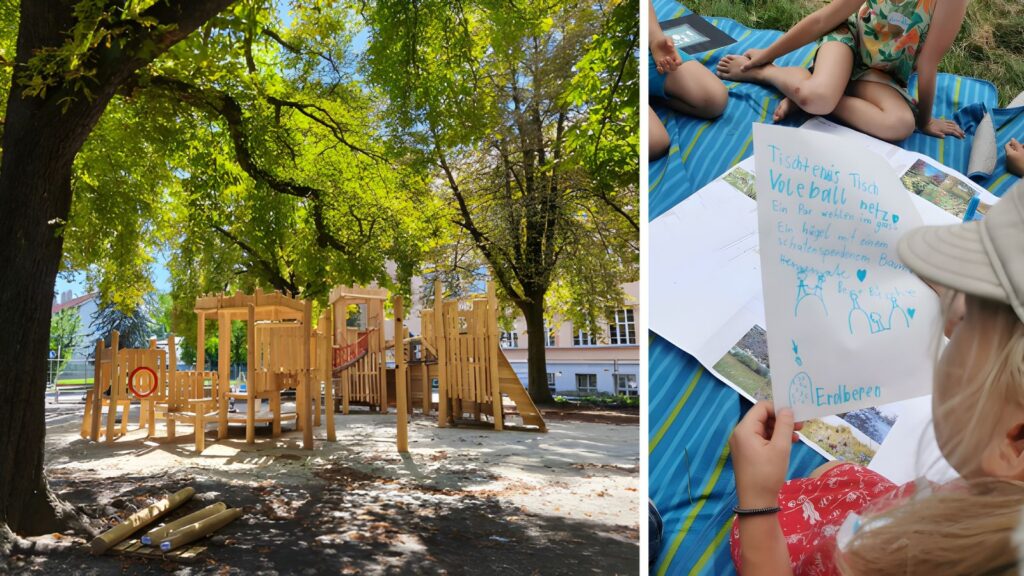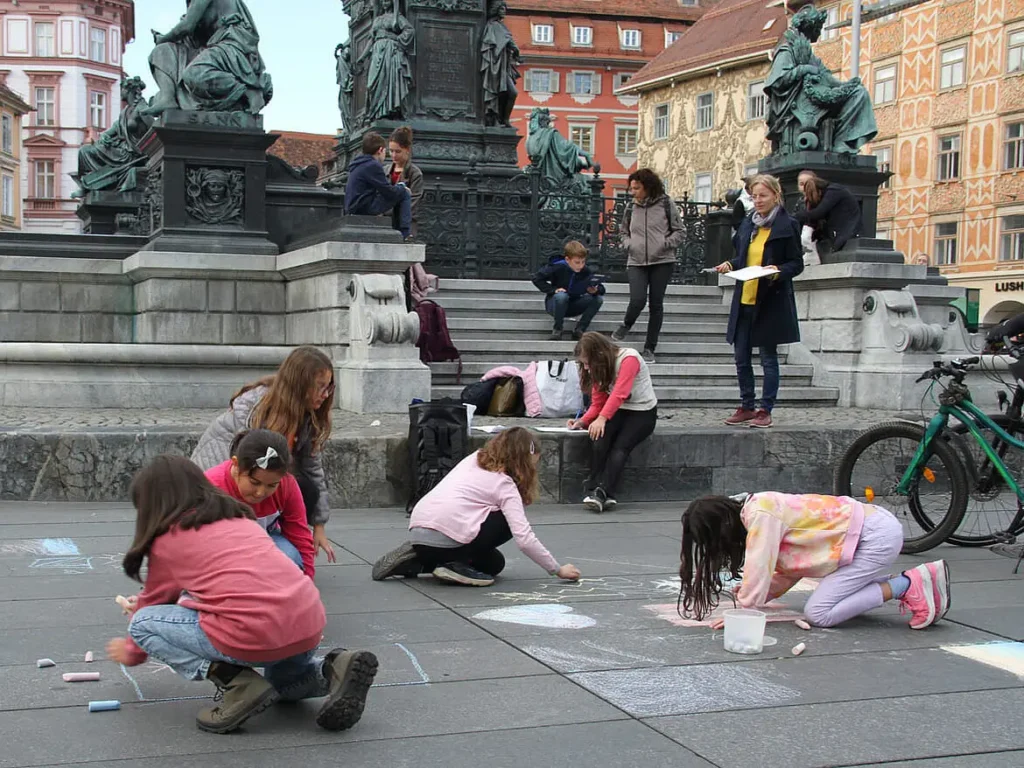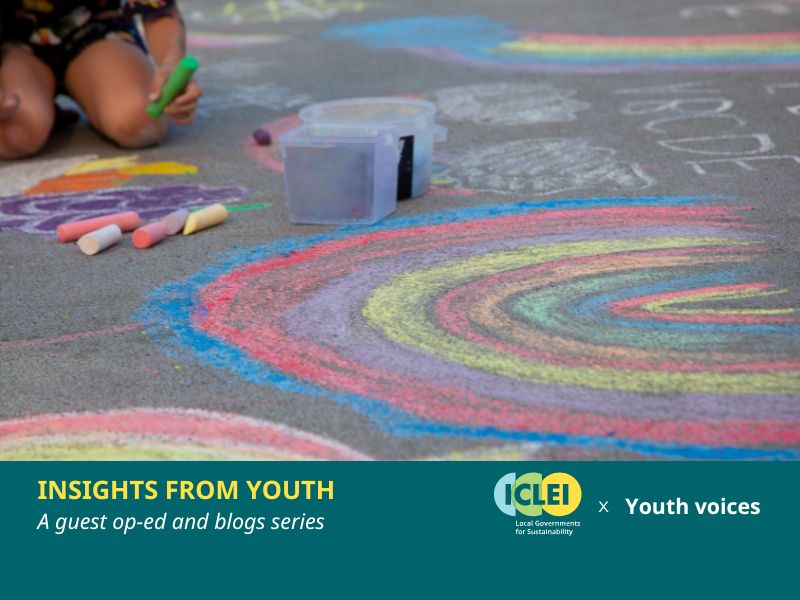Turning play into participation: Building child-friendly, climate-resilient cities
* This blog was written by John Warren Tamor as part of a partnership between ICLEI and YOUNGO Cities Working Group, contributing to “Youth Voices,” ICLEI’s guest op-ed and blog series, featuring insights from young changemakers.
Nestled in the heart of Styria state, the Austrian city of Graz breathes culture and creativity. With a population of nearly 300,000—20% of whom are students—Graz is not only steeped in culture and history but also stands out as a model for child and youth-friendly urban design. Strolling through Graz, it’s easy to see the city’s commitment to creating spaces that nurture the sense of responsibility of its youngest residents towards nature.
“Children’s spaces are [often] reduced to playgrounds. We take exactly the opposite approach. Playgrounds are only a small part,” explained Matthias Preinknoll, a landscape architect from the City’s Department of Green and Open Space Planning.
According to Matthias, experiences like touching soil, encountering insects, or caring for plants are fundamental elements of growing up. Graz is weaving green spaces into children’s everyday environment—not just playgrounds—and education through nature trails, edible gardens, and summer workshops such as “Experiencing Nature.”
These initiatives encourage curiosity, responsibility, and hands-on learning, ensuring that natural environments are not just places to visit but integral spaces to explore and grow. At the same time, children are also seen as active members of society: Matthias has worked to bring their perspectives into planning processes, sometimes through informal conversations, so that their voices help shape the city’s green future. For him, the most meaningful contributions often begin in these casual discussions, where children’s ideas and observations naturally emerge and can directly influence planning decisions.

Photos ©Matthias Preinknoll
What does it take to build child-friendly cities
“Local level is the nucleus of democracy … It fosters the development of young people, they learn how to speak up, how to solve conflict and how to increase their self-efficacy,” emphasized Julia Wögerbauer, who coordinates UNICEF Austria’s Child Friendly Cities Initiative (CFCI) program. Indeed, this goes beyond consultation but well into actively fostering young people’s involvement in municipality decisions, helping them develop capacities that are essential for shaping resilient and inclusive urban futures.
In Graz, for instance, the Children’s Office serves as both a lobby and liaison for young people, ensuring that their concerns are heard, their participation is structured, and their interests are systematically integrated into city planning processes.
This model is particularly relevant in the face of one of today’s urgent global challenges: Climate change. In a recent workshop Julia facilitated on climate and child rights, young participants expressed a deep sense of climate anxiety. Faced with the vastness of the crisis, many felt overwhelmed.
“We had to find a good ending,” Julia recalled. “We cannot change the whole world, but we can start with little things.” She emphasized that this is where local-level participation becomes so powerful as it offers tangible opportunities for impact, where youth can see the results of their contributions, a sense of agency and control, in contrast to the helplessness that often accompanies global-scale issues.

The climate crisis is a child rights crisis
Early civic engagement plants the seed for long-term civic-mindedness and care towards the planet. This approach is part of a broader model of child-friendly cities promoted by the CFCI, which not only prioritizes children’s rights and well-being but also embeds their perspectives into climate adaptation strategies.
By incorporating formal youth participation mechanisms and tailoring urban planning to children’s needs, municipalities demonstrate how local governments can effectively respond to the complex challenges posed by climate change, while also strengthening democratic governance and social inclusion.
In 2023, the UN Committee on the Rights of the Child issued General Comment No. 26, a landmark interpretation that connects the dots between climate change and children’s rights. They stated that environmental degradation not only endangers children’s rights to a clean and healthy environment but also undermines access to essentials like education, health care, clean drinking water, and sanitation.
Crucially, it doesn’t just call on national governments to act; it emphasizes that local governments and other actors play a critical role in defending these rights. As a result, climate action is no longer a fringe concern within upholding child rights, but it’s becoming a central pillar.
Building child-friendly cities is a climate adaptation strategy
Today, 1.8 billion people around the world are under the age of 25, yet city planning rarely reflects their lived realities or future needs. In fact, the Children’s Climate Risk Index (CCRI) reported that around one billion children, or more than half of the world’s child population, live in areas classified as extremely high-risk to climate disturbances.
This oversight isn’t just an equity issue but a missed opportunity for effective climate adaptation, especially since children are among those most at risk. Children’s bodies and minds are uniquely vulnerable to the impacts of climate change such as pollution, deadly diseases and extreme weather. This means for children increases in heat-related illnesses, childhood diseases and mental health problems, disrupted education and malnutrition.
Cities that are planned with and for young people are not only more inclusive; they are more resilient, safer, and future-oriented. In this sense, building child- and youth-friendly cities is itself a climate adaptation strategy. It ensures that the generations who will face the brunt of climate impacts are not only protected but also actively engaged in shaping more sustainable urban futures.
Intergenerational city planning
The city of Feldbach, also in Austria, provides a concrete example of this approach through its Kindergemeinderat program. The program allows children to participate in planning public spaces, initiating projects, and raising issues that matter to them.
Kevin, the current Kinderbürgermeister or Child Mayor, is an energetic and curious 11- year-old boy who loves discovering how his town works and enjoys sharing ideas with friends. He reflected on his participation: “You can learn a lot about the city and decide and say: ‘For example, maybe I’d like to have that there now,’ and then it might even be implemented.”
Lion, 11-year old, also a part of the Kindergemeinderat or the Children’s Municipal Council, is enthusiastic, engaged, and values the opportunity to participate. He enjoys being part of the activities and projects, finds them fun, and is confident that he will remember the experience for years to come, even if some of his friends didn’t share the same interest.
The Kindergemeinderat program illustrates how participation can serve as a form of intergenerational learning. They share their ideas, ask questions, and even think about the tricky choices city planners face. At the same time, the city learns from their fresh perspectives, which might be missed in usual planning. When supported effectively, this kind of participation can help cities plan more thoughtfully for the long term, potentially making them stronger, safer, and better prepared to face the challenges of climate change.
COP30 Call to Action: Make climate policy child-ready
The experiences of Graz and Feldbach illustrate how child-friendly cities are not only advancing children’s rights but also providing scalable models of local climate adaptation. As the climate crisis deepens, local governments cannot afford to overlook the perspectives and needs of those who will inherit the impacts of today’s decisions.
At the global level, this urgency must translate into concrete commitments. In the upcoming COP30, local, regional, and other subnational governments should urge Parties to recognize children and youth as key stakeholders in climate policy and to include child-sensitive priorities within National Determined Contributions, National Adaptation Plans, and long-term strategies, in consultation with child- and youth-led organizations.
By embedding child rights into the climate agenda, COP30 and future negotiations can help ensure that climate action is not only ambitious but also just, inclusive, and intergenerational.
* About the author
John Warren Tamor is an urban innovation professional specializing in helping cities and regions advance smart and sustainable development. He currently serves as a Contact Point for the Working Group on Cities at YOUNGO, the Official Youth Constituency to the UNFCCC.
He holds an MSc in Transition, Innovation, and Sustainability Environments, and is now pursuing a Dual Doctorate in Public Policy and Management. His research explores the twin transition in the context of smart cities and innovative public policy frameworks.







